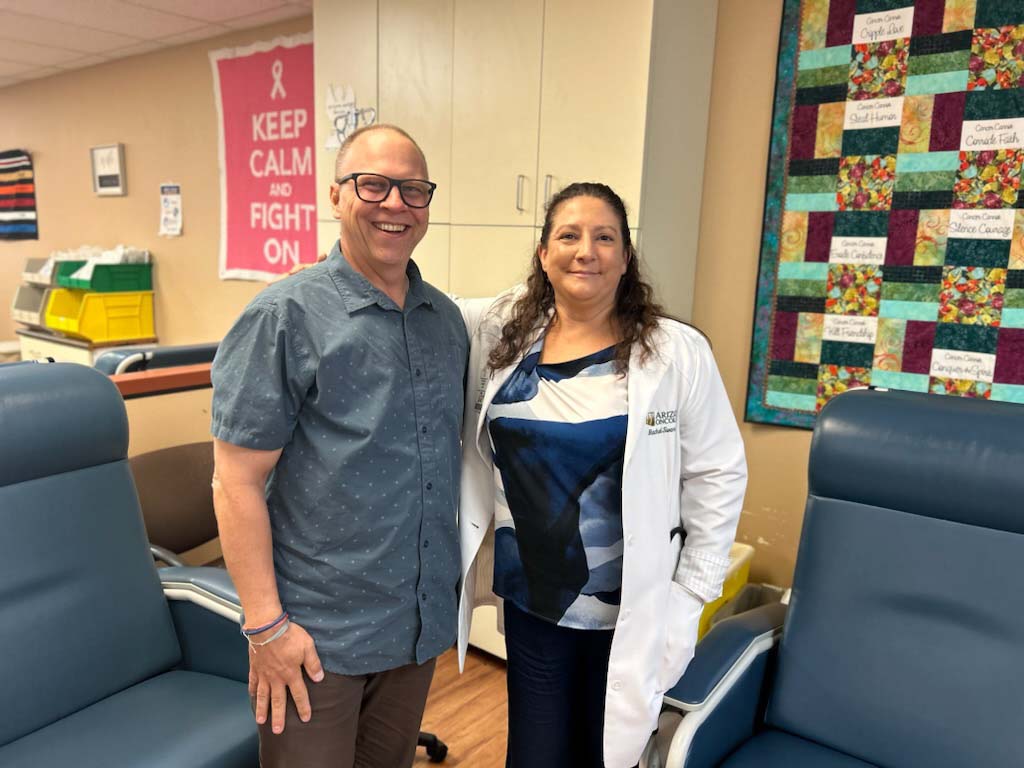Men make up only 1% of breast cancer diagnoses or about 2,650 cases each year in the US. Tom Tronsdal was one of them.
“I was scratching my chest one day and felt a lump. I’ve had a cyst before and had it removed, so I just called the dermatologist’s office to go. I mean, literally, I thought I would go get it taken out,” Tom recalls. When he arrived for that appointment, his doctor immediately recognized that the lump was suspicious and referred him out. He underwent a mammogram, ultrasound, and then a biopsy. It turned out to be cancer.
I just had this hunch, you know
Tom had no family history of breast cancer—male or female—but he had a feeling the biopsy would come back positive. “I just had this hunch, you know, and so I wouldn’t say I was relieved to get the diagnosis, but I was relieved at least to know something, and then I could do something.”
Surgery was scheduled with Dr. Karen Hendershott, followed by chemotherapy overseen by Dr. Rachel Swart. Both Arizona Oncology physicians are breast cancer survivors themselves. “(Doctor Hendershott) was very calming, very soothing. She did a great job of explaining the cancer to me. That was the first time I really had somebody say, ‘This is what cancer is. This is what the cell looks like. This is why this is happening’,” Tom recalls. “Dr. Swart actually was terrific. It was very positive in terms of how she explained the nature of my cancer, its status. She was very specific, so that helped me a lot in getting answers.”
They kept moving the goalposts on me
Tom’s cancer turned out to be more rare and aggressive than expected. Instead of four chemotherapy treatments, he needed six. When his tumor came back as HER2 positive, an extremely rare finding, he was told he’d need an additional year of treatment after that. “They kept moving the goalposts on me,” Tom explains. He also had “every single side effect,” making life very difficult.
“You know, with any chronic illness, it’s just there’s no letting up. I mean, that’s the challenge. The treatments are hard. Cancer is hard. But the fact is that there’s just no break from it physically because it just wrecks your body for several months,” Tom explains.
He goes on, “There were some long days here, you know, where my treatments were six to seven hours long. So there were days I spent a whole day here getting the chemo done.”
Tom’s wife, Amanda, was a huge support as well, not only taking on more responsibilities at home when Tom was too sick, but in helping to make sure his doctors had all the details they needed to make care decisions. “I’m terrible with the medical stuff,” Tom confesses, “so the doctor would ask me a question, and I’d say ‘no’ to some symptom I was experiencing, and she would be like, ‘No, you are having these symptoms. Don’t downplay them’.”
People want to help, but the reality is most people just can’t
Tom’s friends were very supportive when they learned of his diagnosis, and while there wasn’t a lot they could do for him physically, Tom found a great way to acknowledge their support and allow them to lift his spirits. “People are so nice. People want to help, but the reality is most people just can’t, right?” Tom acknowledges. “I was gonna lose my hair, and I just told everybody in my group of friends, ‘just send me a hat of some place or something that matters to you’.”
His friends delivered. Tom received 15 hats sporting the logos of sports teams or local businesses that meant something to his friends or represented experiences they’d shared together. “I have a friend of mine from New Jersey that sent me a hat for Bruce Springsteen because that’s who we would listen to in high school. A friend of mine in Kansas—we both like riding bikes—she sent me a hat from the local bike shop in Lawrence, Kansas. I had a friend of mine who six or seven years ago, we went to New York City with our kids (…) and we rode bikes over the Brooklyn Bridge. We did like 12 miles that day all over Manhattan—it was one of our favorite days we experienced. He got me a hat from that bicycle store where we got the bikes in Brooklyn. And that was so thoughtful. Like, they’re all thoughtful.”
Everything’s pink
Although Tom’s family and friends were there for him, it was difficult to find support from others who were going through the same thing he was. Male breast cancer is so rare that even online resources and stories are scarce.
“I think the challenge is trying to fit into the breast cancer world, you know, because support groups really aren’t designed for men,” Tom says. He points out that, for women, breasts represent so many things—sexuality, womanhood, motherhood, and women can band together to help each other through those aspects of the disease, which is a good thing. “They are just totally different issues, you know, so there aren’t a lot of resources for men out there,” Tom acknowledges. “And, you know, everything’s pink.”
Tom is quick to point out that he’s got nothing against wearing pink, but he still wanted to know what breast cancer meant for him, as a man. In his search for information, he ended up Googling mortality rates for male breast cancer and was shocked at how high they were. “I’m like, what the heck, right? And it was crazy high. Like I thought breast cancer was, you know, survivable.” What he quickly realized was that the high rates were often due to the cancer being found at a later stage. For example, the American Cancer Society reports that the 5-year relative survival rate for male breast cancer being found in the localized stage is 95%. In the regional stage, it’s 84%, but in the distant stage, after it has metastasized, or spread, it’s only 20%.
Because Tom was quick to get in to see his doctor when he noticed the lump, his cancer had not spread. “I think it’s just really important, regardless of breast cancer or not, for anyone—if you see something, do something. Just go have it checked out,” Tom urges.
I’m still the same puzzle, but the pieces are different now
Now that his treatment is over, Tom is learning what being a post-treatment cancer survivor looks like. His therapist is helping. “Dr. Falcon told me it takes like a year to 18 months to get over the physical challenge of having cancer. And it takes a year after that to come to terms with actually having had cancer.” He says he didn’t understand that at the time, but now he does. When he was undergoing treatment, he was so overwhelmed with the physical aspect of it that there wasn’t an opportunity to focus on the mental, emotional, or spiritual part.
Tom has come up with an analogy to help him sort out his thoughts and feelings. “So, let’s say I’m a jigsaw puzzle, you know, and who I am is made of all these different pieces. So what’s happened now, and how do I want to become myself post-treatment? I’m still the same puzzle, but the pieces are different now. I have a couple of new pieces that I didn’t have before. Similar pieces might be a little smaller. And they’re shaped differently again, and so that’s how I am trying to face this next stage: I’m still the same person, the same puzzle, it’s just the parts are a little bit different, and that’s OK. It still means that most of what made me ‘me’ is still there, and I’m trying to get back to that being normal again.”
I’m healthy and happy
Now that Tom has finished treatment, he’s revisiting a passion project that he had to sideline when he got his diagnosis—starting a book club that highlights underrepresented authors. “I was just able to schedule my first book club meeting for November because I’m healthy and happy,” Tom says with a grin.
His club meeting will begin with speakers from underrepresented communities matching that of the featured book. He hopes having their perspectives will help add a layer of depth to the reading of these books, which aren’t necessarily about dealing with prejudice, rather “are really good stories written by people you don’t normally read about.”
The first book to be featured in November 2024 is “Wandering Stars” by Tommy Orange, a Native American author. “My book club is going to have these two indigenous speakers beforehand to flesh it out for us, and then we can talk about the book. I always thought it would be really fun. One of the fun things to be able to experience coming out of this year is to be able to do something I’ve wanted to do,” Tom says.
For more information on breast cancer and breast cancer treatment in Arizona, visit www.arizonaoncology.com.



